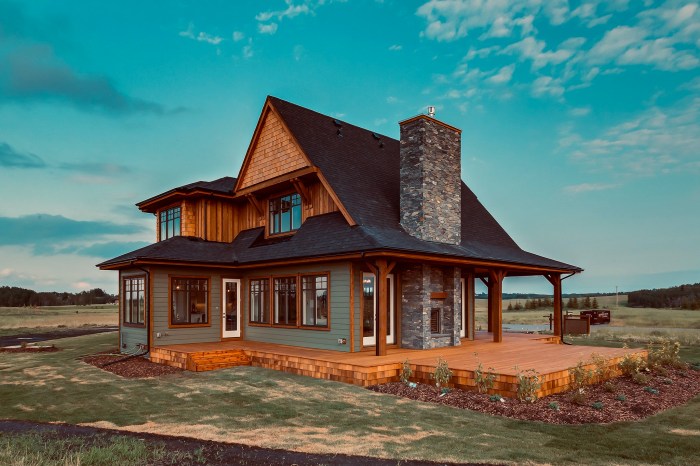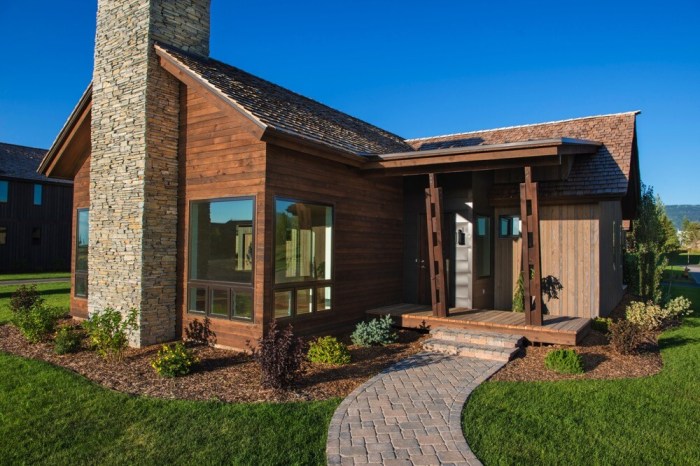Crafting a Natural Wood Siding House: Enhancing Your Home with Timeless Elegance
In the realm of home design, natural wood siding houses stand out for their timeless beauty and unmatched charm. As we delve into the world of natural wood siding, a realm where craftsmanship meets nature, readers are invited to explore the captivating allure of this classic architectural choice.
Natural wood siding has long been revered for its unique characteristics, from its warm hues to its durability, making it a popular choice among homeowners seeking to infuse their dwellings with a touch of rustic elegance.
Overview of Natural Wood Siding Houses

Natural wood siding is a popular choice for homeowners looking to add a touch of warmth and authenticity to their houses. It is known for its timeless appeal and unique characteristics that can enhance the overall aesthetic of a home.
There are several benefits to using natural wood siding for houses. One of the main advantages is its natural beauty and versatility, as wood can be shaped and treated in various ways to achieve different looks. Additionally, wood siding is environmentally friendly and sustainable, making it a popular choice for eco-conscious homeowners.
Types of Wood Commonly Used for Siding
- Cedar: Known for its natural resistance to decay and insects, cedar is a popular choice for wood siding. It has a beautiful grain pattern and can be stained or painted to achieve different looks.
- Pine: Pine is a cost-effective option for wood siding and is readily available. It can be treated to improve its durability and resistance to rot and decay.
- Redwood: Redwood is a durable and long-lasting wood that is naturally resistant to decay and insects. It has a rich, reddish-brown color that can add warmth to a home's exterior.
- Cypress: Cypress wood is known for its natural resistance to decay and insects, making it a popular choice for wood siding. It has a straight grain pattern and can be stained or painted to enhance its appearance.
Installation of Natural Wood Siding
When it comes to installing natural wood siding on a house, there are several key steps to follow to ensure a successful and long-lasting result.
Process of Installing Natural Wood Siding:
- Prepare the surface by removing any existing siding and ensuring the walls are clean and dry.
- Apply a weather-resistant barrier to protect against moisture and water damage.
- Install furring strips or a moisture barrier to create an air gap between the siding and the wall, allowing for ventilation.
- Begin installing the wood siding from the bottom up, making sure to leave space for expansion and contraction.
- Secure the siding with appropriate fasteners, making sure to follow manufacturer guidelines.
- Finish the installation by adding trim pieces and applying a protective sealant or stain to enhance durability.
Cost Comparison:
While natural wood siding can be more expensive upfront compared to other siding materials like vinyl or fiber cement, it offers a unique and timeless look that can increase the value of your home.
Maintenance Tips:
- Regularly inspect the siding for any signs of damage, such as cracks or rot, and address any issues promptly.
- Clean the siding annually with a mild detergent and water to remove dirt, mold, and mildew.
- Apply a fresh coat of sealant or stain every few years to protect the wood from the elements and maintain its appearance.
- Avoid using high-pressure washers or harsh chemicals that can damage the wood siding.
Design and Style Options
Natural wood siding offers a wide range of design and style options that can enhance the aesthetics of a house while providing a warm and inviting look. The versatility of natural wood siding allows it to complement various architectural styles, making it a popular choice among homeowners.
Traditional Style
Natural wood siding is a classic choice for traditional style houses, adding a timeless appeal
Modern Style
In contrast, natural wood siding can also be used to bring a touch of nature and warmth to modern style houses. The clean lines and minimalist design of modern architecture can be complemented by the organic texture and natural beauty of wood siding.
Whether it's a sleek, contemporary home or a mid-century modern masterpiece, natural wood siding can add depth and visual interest to the façade.
Rustic Style
For those looking to achieve a rustic or farmhouse style, natural wood siding is the perfect choice. The weathered and distressed look of wood siding can create a sense of history and authenticity, adding a rustic charm to the exterior of the house.
Whether it's a log cabin in the woods or a farmhouse in the countryside, natural wood siding can help achieve that cozy, rustic look.
Coastal Style
Natural wood siding is also well-suited for coastal style homes, where its natural textures and colors can blend seamlessly with the surrounding environment. Whether it's a beach cottage or a seaside retreat, wood siding can evoke a sense of coastal living and relaxation.
The durability of natural wood siding also makes it a practical choice for homes in coastal areas, where it can withstand the elements while maintaining its beauty.
Environmental Impact and Sustainability
When it comes to natural wood siding, the environmental benefits and sustainability play a crucial role in decision-making.
Environmental Benefits of Using Natural Wood Siding
Natural wood siding is a renewable resource, meaning it can be replenished and harvested sustainably. This helps reduce the reliance on non-renewable materials and decreases the carbon footprint associated with manufacturing synthetic siding materials.
- Wood siding acts as a carbon sink, absorbing and storing carbon dioxide from the atmosphere.
- Wood is biodegradable and can be recycled or repurposed at the end of its lifespan, reducing waste in landfills.
- Choosing natural wood siding can contribute to healthier indoor air quality compared to synthetic materials that may emit harmful chemicals.
Sustainability of Harvesting Wood for Siding Purposes
The sustainability of harvesting wood for siding purposes depends on responsible forestry practices. This includes replanting trees, protecting biodiversity, and ensuring the long-term health of forests.
Forestry certifications like FSC (Forest Stewardship Council) ensure that wood products come from responsibly managed forests.
Eco-Friendly Practices Related to Natural Wood Siding
Installation and maintenance of natural wood siding can also be done in an eco-friendly manner.
- Use of locally sourced wood reduces transportation emissions.
- Applying finishes and coatings with low VOC (volatile organic compounds) reduces air pollution.
- Regular maintenance, such as cleaning and sealing, can prolong the lifespan of wood siding, reducing the need for replacement.
Last Word

In conclusion, natural wood siding houses offer a harmonious blend of aesthetics and functionality, creating a space that exudes warmth and character. Whether embracing a traditional design or opting for a more modern look, the versatility of natural wood siding ensures a home that is as enduring as it is beautiful.
Expert Answers
Is natural wood siding durable?
Natural wood siding is known for its durability, especially when properly maintained through regular inspections and treatments.
What are the common types of wood used for siding?
Cedar, redwood, and pine are among the most popular choices for natural wood siding due to their resilience and aesthetic appeal.
How can I prevent wood siding from rotting?
Regularly painting or staining the wood, addressing any moisture issues promptly, and ensuring proper ventilation can help prevent rot in wood siding.
Does natural wood siding require a lot of maintenance?
While natural wood siding does require maintenance, such as staining and sealing, the beauty and longevity it offers make it a worthwhile investment.